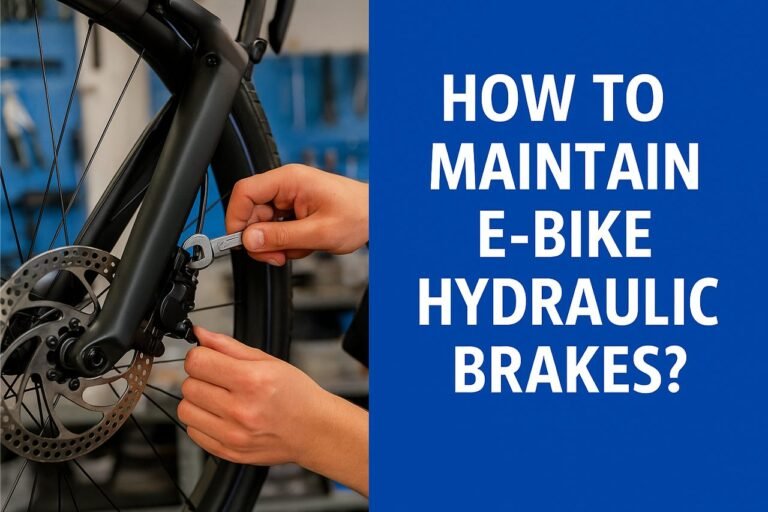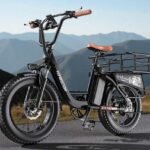![Are E-Bikes Safe? Unpacking the Risks and Regulations ([year]) Are E-Bikes Safe? Unpacking the Risks and Regulations](https://goebikelife.com/wp-content/uploads/2025/06/Are-E-Bikes-Safe.jpg)
Have you ever zipped past a line of cars on your way to work, feeling the wind in your hair and a smug sense of superiority? If you’re an e-bike enthusiast, you probably have. Electric bicycles—e-bikes, as we call them—have exploded in popularity over the last decade, offering a convenient, eco-friendly way to get around.
They’re like the cool cousins of traditional bikes, with a little extra oomph to make your ride smoother and faster. But here’s the catch: with great power comes great responsibility—or, in this case, great speed and a few potential risks.
So, are e-bikes safe? Let’s dive in, unpack the risks, explore the regulations, and figure out how to ride these electric wonders without ending up in a ditch.
What Exactly Are E-Bikes?
Before we get into the nitty-gritty, let’s start with the basics. E-bikes are bicycles with an electric motor that gives you a boost while you pedal—or, in some cases, lets you skip pedaling altogether. Think of it as having a tiny, invisible sidekick pushing you along. There are two main types: pedal-assist e-bikes, which kick in when you start pedaling, and throttle-controlled e-bikes, which let you zoom along with just a twist or a press, no legwork required.
The appeal is obvious. Hills? No problem. Long commutes? Piece of cake. Carrying groceries or a kid? Easy peasy. Plus, they’re kinder to the planet than cars, cutting down on emissions while still getting you where you need to go. But that extra power is a double-edged sword, and it’s where the safety questions start creeping in.
The Speed Factor: Thrilling but Risky
Let’s talk about speed first, because it’s one of the biggest differences between e-bikes and their pedal-powered cousins. A traditional bike might get you up to 15-20 miles per hour if you’re really huffing and puffing, but e-bikes? They can hit 28 mph or more, depending on the model. That’s exhilarating—until it’s not.
Picture this: You’re cruising down a shared bike path, the sun’s out, the birds are chirping, and life feels good. Suddenly, a jogger steps out from behind a bush. On a regular bike, you’ve got a decent shot at braking or swerving in time. On an e-bike going full tilt, though? That window shrinks fast. It’s like trying to stop a runaway horse—you might manage it, but it’s going to be a close call.
The numbers back this up. A 2022 report from the National Highway Traffic Safety Administration (NHTSA) found that e-bike accidents often involve higher speeds than traditional bike crashes, leading to more severe injuries. In fact, e-bike-related injuries have jumped by 30% over the past five years. Speed is a thrill, but it’s also a risk, especially if you’re not used to handling it.
Weight: The Heavy Truth
Then there’s the weight issue. E-bikes aren’t lightweights. Thanks to the battery and motor, they can weigh 50% more than a standard bicycle—sometimes tipping the scales at 50-70 pounds or more. That’s a big shift if you’re used to a featherweight road bike.
I learned this the hard way when I borrowed my buddy’s e-bike for a spin. I’m no stranger to cycling, but the first time I took a sharp turn on that thing, it felt like wrestling a stubborn mule. The extra heft makes a difference—stopping takes longer, turns feel less nimble, and if you lose your balance, good luck catching yourself before you hit the ground.
For new riders, this can be a real challenge. The NHTSA notes that the added weight can affect stability and handling, especially in tricky situations like wet roads or crowded streets. It’s not that e-bikes are impossible to ride; it’s just that they demand a little more respect—and muscle—than you might expect.
Battery Safety: Don’t Let It Burn
Now, let’s get into something a bit more explosive—literally. The lithium-ion batteries that power e-bikes are marvels of modern tech, but they’re not without their quirks. If mishandled, they can overheat, catch fire, or even blow up. And no, that’s not an exaggeration.
A couple of years back, I heard about a guy in my town whose e-bike battery went up in flames while charging in his garage. The fire spread fast, torching his workbench and half his tool collection before the fire department got there. He was fine, thank goodness, but his garage? Not so much. Stories like that stick with you.
So, what causes this? Sometimes it’s a manufacturing defect—cheap batteries can be a gamble. Other times, it’s user error: overcharging, using the wrong charger, or storing the battery somewhere hot and humid. The Consumer Product Safety Commission (CPSC) has tracked dozens of e-bike battery fires in recent years, and they’re pushing for stricter safety standards as a result.
Here’s how to keep your battery from turning into a fireball:
- Use the right charger. Stick with the one that came with your bike—don’t cheap out with a knockoff.
- Don’t overcharge. Unplug it once it’s full, even if you’re tempted to leave it overnight.
- Store it smart. Keep it in a cool, dry spot, away from flammable stuff like paint cans or old rags.
- Check for damage. If the battery’s swollen, leaking, or smells weird, don’t mess around—get it checked by a pro.
It’s basic stuff, but it could save your house—or your life.
The Regulatory Puzzle: Where Can You Ride?
If you think e-bike safety is just about the bike itself, think again. Where and how you ride matters, and that’s where regulations come in. The catch? They’re all over the place.
In some spots, e-bikes are treated like regular bikes—ride them on bike paths, no license needed, helmets optional. In others, they’re closer to mopeds or motorcycles, with rules about registration, insurance, and mandatory gear. It’s a patchwork that can leave your head spinning.
Take the European Union, for example. They’ve got a neat system with three categories: pedelecs (up to 25 kph, no throttle), S-pedelecs (up to 45 kph, stricter rules), and full-on e-bikes that need a license. Makes sense, right? Now compare that to the U.S., where every state does its own thing. In California, you can ride most e-bikes on bike lanes, no problem. In New York City, throttle e-bikes were banned for years until the rules loosened up in 2020. Confused yet?
John Doe from the E-Bike Safety Council puts it well: “Navigating the regulatory landscape can be tricky, but it’s crucial for riders to understand the laws in their area to ensure they’re riding safely and legally.” Translation: Google your local e-bike laws before you roll out. A ticket—or a tangle with a cop—is no way to start your day.
Safety Features: What Manufacturers Are Doing
E-bike makers aren’t sitting on their hands, though. They know safety sells, and they’re packing their bikes with features to keep you upright. Think integrated lights for visibility, reflective strips on the frame, and beefy brakes that can handle the extra speed and weight.
Take XYZ E-Bikes, for instance. Their latest models come with anti-lock braking systems (ABS)—yep, like in cars—which stop you from skidding out on slick roads. They also throw in a safety guide with every purchase, covering everything from tire pressure to emergency stops. Some companies even host free workshops to teach you the ropes. It’s like getting a crash course—pun intended—with your new ride.
But here’s the thing: no gadget can replace rider know-how. A fancy brake won’t save you if you’re barreling down a hill with no clue how to use it. That’s where education comes in.
Rider Responsibility: It’s on You
At the end of the day, e-bike safety boils down to the person in the saddle. You can have the safest bike on the planet, but if you’re reckless, you’re rolling the dice.
Here’s a quick rundown of how to stay safe:
- Wear a helmet. I don’t care if it messes up your hair—it’s your head we’re talking about.
- Start slow. Get comfy with the bike’s power before you crank it to max speed.
- Stay alert. No texting, no daydreaming—keep your eyes on the road.
- Check your ride. Tires, brakes, battery—give it a once-over before you go.
- Learn the ropes. If there’s a safety course near you, take it. Trust me, it’s worth it.
I took one of those courses a while back, and it was a game-changer. We practiced emergency stops, dodged fake obstacles, and even learned how to fall without breaking every bone in our bodies. I felt like a biking ninja by the end—and a lot less likely to eat pavement.
The Numbers Game: What the Data Says
Want some hard facts? Let’s dig into the stats. The E-Bike Safety Alliance reports that e-bike injuries have spiked 30% in five years, with the most common culprits being collisions (with cars, pedestrians, or other bikes) and loss of control. Speed’s a factor, sure, but so is inexperience—new riders are disproportionately likely to crash.
On the flip side, a study from the Journal of Transport & Health found that e-bike accidents aren’t inherently more dangerous than regular bike ones when you adjust for how many people are riding them. The catch? E-bikes attract a wider crowd—older folks, less-fit riders—who might not have the reflexes or bike-handling skills of a seasoned cyclist. It’s not the bike; it’s the rider.
And here’s a wild stat: the CPSC says e-bike battery fires, while rare, have caused over 200 incidents since 2019, including a handful of fatalities. That’s a tiny fraction of all e-bike users, but it’s enough to make you double-checked your charger.
Real-Life Lessons: Mike’s Story
Let me tell you about my friend Mike. He’s a bike nut—racks up hundreds of miles a year on his road bike. When he got an e-bike, he was over the moon. The speed! The power! He felt invincible—until he wasn’t.
One sunny afternoon, he took it down a steep hill near his house. He was flying, probably hitting 25 mph, when he hit a pothole he didn’t see coming. The bike bucked, he went over the handlebars, and bam—broken arm, scraped-up face, the works. He was wearing a helmet, thank goodness, or it could’ve been worse. Mike’s fine now, but he’ll tell you himself: “I got cocky. That bike’s no toy.”
Mike’s crash wasn’t unique. The NHTSA says potholes, curbs, and uneven pavement are top causes of e-bike spills. Lesson learned: respect the machine, and watch where you’re going.
Advocacy and Infrastructure: A Bigger Picture
Groups like the E-Bike Safety Alliance aren’t just crunching numbers—they’re pushing for change. They want better bike lanes, clearer signs, and more education campaigns to keep riders safe. Their logic? If cities make room for e-bikes, fewer people get hurt.
Take my town, for example. We’ve got one decent bike lane, but it’s shared with pedestrians and ends abruptly at a busy intersection. Riding an e-bike there feels like playing dodgeball with cars. Advocacy groups say that’s got to change—dedicated lanes could cut accidents by a third, based on studies from bike-friendly places like the Netherlands.
They’ve got a point. Infrastructure isn’t sexy, but it saves lives. Until then, it’s up to us to ride smart.
Government’s Role: Rules and Resources
Government agencies are in on this, too. The U.S. Department of Transportation (DOT) sets standards for helmets and lights, and they’re starting to fund e-bike safety projects. Last year, they handed out free helmets in a dozen cities, along with pamphlets on safe riding. Small steps, but it’s something.
On the regulatory side, they’re trying to keep up with the e-bike boom. Some states are tweaking laws to match the EU’s tiered system—low-speed e-bikes get a pass, high-speed ones get more scrutiny. It’s a balancing act: encourage green transport, but don’t let it turn into chaos.
The Tech Edge: Safety Innovations
E-bike tech is evolving fast, and safety’s a big focus. ABS brakes are popping up on high-end models, cutting stopping distance and skids. Some bikes have traction control to handle slippery roads, while others use regenerative braking—slowing you down while charging the battery. Cool, right?
There’s more on the horizon. Smart helmets with crash sensors that call 911 if you wipe out. Apps that warn you about potholes or traffic ahead. It’s like something out of a sci-fi movie, but it’s real—and it could make e-bikes safer than ever.
Still, tech’s only half the equation. A smart helmet won’t help if you’re weaving through traffic like a maniac. That’s on you.
Case Studies: Learning from the Crashes
Let’s break down a couple more real-world examples to hammer this home.
Case 1: Sarah’s Close Call
Sarah, a 40-something mom, got an e-bike to commute to work. She loved it—until she hit a patch of gravel on a turn. The extra weight threw her off, and she slid into a curb, spraining her wrist. What went wrong? She was new to e-bikes, didn’t adjust for the weight, and didn’t know gravel’s a killer on heavy bikes. A quick safety lesson could’ve spared her the pain.
Case 2: Tom’s Battery Blunder
Tom, a DIY guy, bought a budget e-bike online. The battery was a no-name brand, and he charged it with a generic plug. One night, it overheated and sparked a fire in his apartment. He got out, but his place was gutted. The takeaway? Stick with reputable brands and follow the manual.
These aren’t just stories—they’re warnings. E-bikes are awesome, but they’re not foolproof.
Tips for Every Rider: A Safety Checklist
Ready to ride? Here’s a beefed-up checklist to keep you in one piece:
- Gear up. Helmet, gloves, reflective vest—look like a nerd if it means staying alive.
- Test the waters. Practice in a parking lot before hitting the streets.
- Know your bike. Read the manual—yes, all of it. Understand the motor, brakes, everything.
- Plan your route. Stick to bike-friendly paths when you can.
- Maintain it. Check tires, brakes, and battery weekly. A little TLC goes a long way.
I’ve gotten into the habit of running through this list every time I borrow an e-bike. It’s second nature now, and it’s kept me crash-free so far.
The Future: Safe and Sustainable?
E-bikes are here to stay, and they’re only getting better. As tech improves and cities adapt, the risks could shrink. Imagine a world with smart bikes, perfect bike lanes, and riders who know what they’re doing. That’s the goal—and we’re inching closer.
But for now, safety’s a team effort. Manufacturers can innovate, governments can regulate, and advocates can push—but you, the rider, hold the reins. Ride smart, stay informed, and enjoy the journey.
Wrapping Up: Safety First, Always
So, are e-bikes safe? Yes—and no. They’re as safe as you make them. The risks—speed, weight, batteries—are real, but they’re manageable with the right knowledge and habits. Regulations vary, but they’re there to guide you, not trip you up. And with a little care, e-bikes can be a game-changer: fun, green, and practical.
Next time you hop on, think about Mike, Sarah, and Tom. Take it slow, gear up, and respect the ride. After all, isn’t it better to roll up to your destination a little late but in one piece? Happy riding, folks—stay safe out there!


![[year] E-Bike Rebates & Incentives: US, Canada, UK & EU (Updated Guide) 2025 E-Bike Rebates Explained: Where to Apply and How to Max Your Savings](https://goebikelife.com/wp-content/uploads/2025/09/E-Bike-Rebates-Explained-768x512.jpg)





